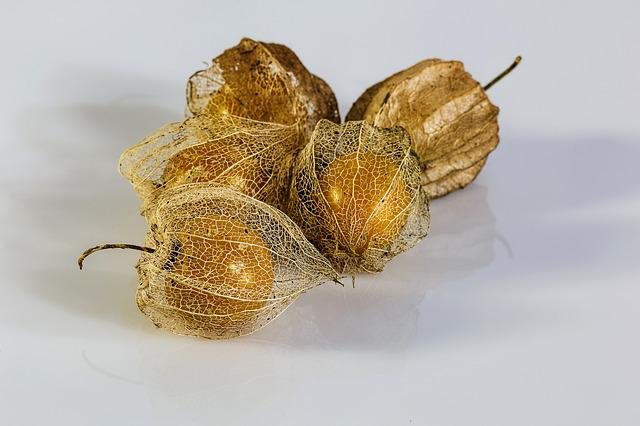
Yellow and orange fruits of Japanese origin also known as the “Chinese lantern”, the alkekengi is a fruit particularly appreciated in the oriental world for its nutritional and also aesthetic qualities.
Hidden by a chalice of leaves reminiscent of tissue paper, we find this autumn fruit rich in vitamin C, used by our ancestors as a natural purifier. The alkekengi aesthetically resembles a small tomato, to the greasy touch and with gold and yellow tones.
Physalis alkekengi, better known as alkekengi, is a herbaceous plant belonging to the Solanaceae family. It resists very well even the most intense cold and therefore, it can also be grown in pots during the cold seasons. In addition to beautifying your garden or balcony, it will be for you a continuous source of fruits with immense beneficial properties.
It can be found easily in most regions. The slightly citrusy flavor is truly irresistible. Of the whole plant, only the fruit the size of a cherry is edible. The leaves that surround it contain instead solanine, a toxic substance for the organism. Let’s now see the nutritional values and properties of this food.
Nutritional values for 1 cup of physalis:
- Waterfall: 85.4 g
- kcal: 66
- Proteins: 1 g
- Carbohydrates: 15 g
- Soccer: 41 mg
- C vitamin: 41 mg
- Vitamin A: 450 IU
- Iron: 0.5 mg
- Glycemic index: 15
- Cholesterol: 0 g
Alkekengi: properties
Alkekengi is considered a safe fruit, which offers many benefits to the body and can well complement a healthy and balanced diet. Among the best known and renowned properties, we find its being a purifying and a natural diuretic. In the field of herbal medicine it is used to treat kidney stones and gout.
Alkekengi is a plant rich in mucilage, flavonoids and carotenoids. It is an excellent antioxidant, capable of integrating good quantities of vitamin C into the body. Thanks to this vitamin, it is able to raise the body’s natural immune defenses, also acting as a protector against the stomach, liver and urinary tract. It is also a good source of Vitamin A.
Integrating Alkekengi into your diet allows you to increase the amount of antioxidants and vitamins in your diet, as well as supplement some minerals, such as iron and calcium, which are useful for bone health.
Alkekengi: benefits
Alkekengi purify the liver and kidneys, support the immune system and protect the body from both flu and chronic diseases caused by viruses and bacteria.
It acts in particular on the urinary tract, purifying them and preventing the formation of kidney stones. Its beneficial properties also extend to the skin, thanks to the vitamin C content that stimulates the production of collagen.
The infusion of alkekengi is used in phytotherapy for the treatment of gout and for those problems related to water retention. Its leaves are toxic to the body but, when used externally, they act as relaxing compresses to relieve skin inflammations.
Furthermore, it is interesting to note that compounds called withanolides have recently been isolated from the Physalis species, which have shown anti-inflammatory properties and useful in cancer prevention. More specifically, in some studies the witanolide extract showed cytotoxicity towards cancer cells. However, further studies are needed to confirm this property.
Alkekengi: contraindications and side effects
The fruit of the alkekengi has no particular contraindications. However, some studies have shown that their intake may interfere with that of some medicines, such as diuretics. For this reason, if you are following a treatment, start consuming alkekengi only after asking your doctor for advice.
The speech is instead different with regard to the oval-shaped leaves that surround the fruit. They are particularly rich in solanine, a substance that can be toxic to the body, especially if taken in large quantities. Symptoms range from vomiting, diarrhea, nausea and headache. They typically disappear within 24 hours.
Like all other solanaceae, alkekengi can have traces of alkaloids, which are mainly present in leaves and stems. Precisely because of the possible contraindications, fresh fruits should be consumed in moderate quantities.
How to use the alkekengi
The fruits of the alkekengi can be eaten fresh or in the dried form, to be consumed as a snack. The jams are particularly good, ideal substitutes for those we buy at the supermarket. The fruit can also be used as an ingredient in sweets, fruit salads and desserts.
The leaves should not be used for food but, considering their particular beauty, they lend themselves very well to different types of decorations. It is no coincidence that they are known as “Chinese lanterns”, used precisely to embellish the windowsills of the house. You can also use alkekengi leaves to decorate some dishes based on this delicious fruit.






